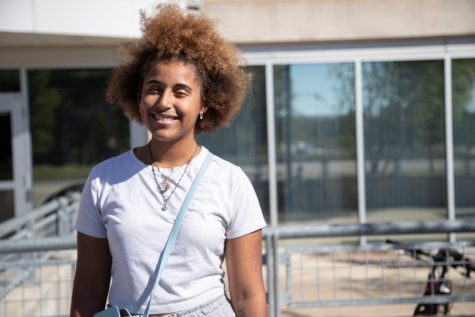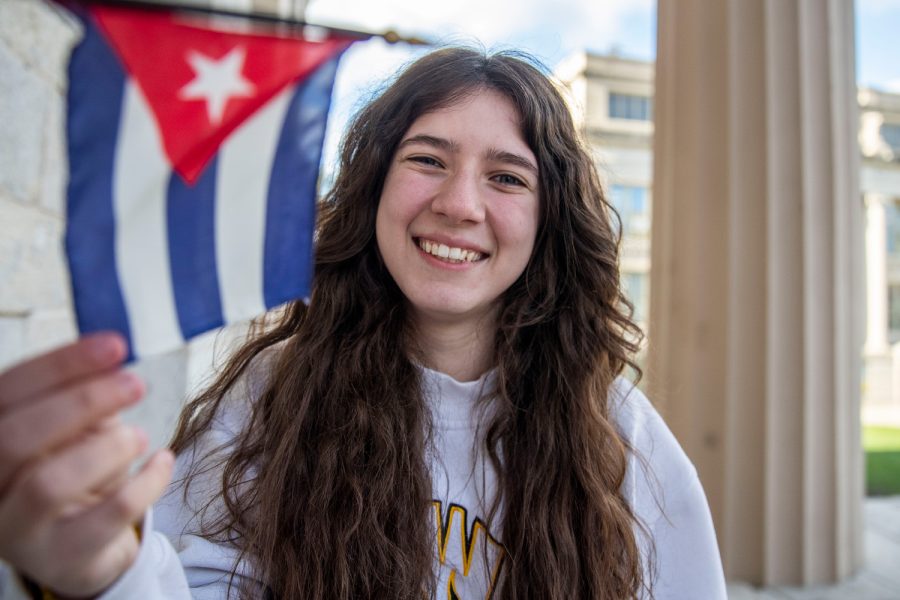Multiracial UI students search for acceptance
Three University of Iowa students discuss how being multiracial has impacted their experiences growing up.
University of Iowa first-year multiracial student Kate Perez poses for a portrait on the Pentacrest on Monday, April 18, 2022.
April 19, 2022
When I was 13, I was told that I would never be truly Hispanic. The words, spoken by a former friend of mine who was Mexican, came after I was trying to explain my Cuban heritage to her.
“I’m half Cuban,” I remember saying, confused. “My dad came from Cuba when he was four. He’s an immigrant. I’m Hispanic.”
“You don’t look Hispanic. You look white,” she responded. “You don’t speak Spanish. You’ll never be actually Hispanic.”
Six years later, I still find myself thinking about that conversation whenever people ask about my heritage. Despite my Cuban background, my skin color and “Americanness” are the first things people notice about me.
My skin is paler than what people assume of a Latino/a/x person, and as a result, many overlook the fact that my last name is Perez.
Often, people immediately assume that I am only white. I have brown hair and blue eyes, speak with no accent, and my name is Katharine. It is not uncommon for Cubans to look like I do, as the country is a mix of people from Spain and Africa, among other countries, meaning many Cubans are already automatically assumed to be white.
Yet, I spent my childhood afternoons in my paternal grandmother’s house eating Cuban dishes like Ropa Vieja and Flan. My family spoke to me in English, despite being around native Spanish speakers often. My grandmother refused to teach me the language because she “didn’t want to be seen as different from her granddaughters.”
My grandmother’s stubbornness disconnected me from my heritage — and meant I was not awarded my official seal of biliteracy in Spanish until my senior year of high school.
Today, even with my fluency in the language and my attempts to better understand the history of where I came from, I still feel like an imposter in the Latino/a/x community. Being white-passing means I am not accepted as Latino/a/x by many.
Maria Engler, a Filipino-American University of Iowa first-year, said she has always struggled with meeting people who look like her.

“Growing up, I wouldn’t really see people that really looked like me, but I was convinced I had white features because that’s what I grew up around,” Engler said. “I just kind of tricked myself to believe that I looked like them so I could fit in.”
Engler grew up in Muscatine, Iowa, where she was often mistaken as Latina due to her name and facial features, she said, despite explaining to her peers she is Filipina.
She said she was made fun of for looking different than other kids and felt “in the middle” of both cultures.
“It’s the confusing part about being mixed race, especially if you’re half-white,” Engler said. “You feel like you don’t identify with people of your own culture, because for me, I feel like I’m not Filipino enough to fit in with them, but I’m not white enough to fit in with white people.”
At the UI, students of two or more races make up 3.2 percent of the fall 2021 enrollment population, while white students make up 74.6 percent, according to the university’s Diversity, Equity, and Inclusion website. For students like me and Engler, it can be hard to understand where we belong when we’re both the minority and a majority in the population.
“When they ask on your application, ‘What are you?’ sometimes you can’t find what you are because you can’t when it says ‘other,’” Engler said. “Sometimes when people are mixed race, typically they default [as] white because they don’t want to experience racism on campus.”
Growing up, Engler was raised to adopt American culture more than her Filipina side. As a result, she said she doesn’t know how to “act” Filipina or connect to her culture.
“I’ve been raised to be American. The idea of ‘forget your culture, because now you’re here. You don’t live there,’” Engler said. “You have to kind of identify with what you can and want to, because you will never be fully Hispanic or fully Filipino because you’re mixed. That’s just not how you are made, sadly enough.”
Engler is not alone in her struggle to find where she belonged while growing up.
E’mma Camara, a biracial first-year student, said she shared similar experiences while growing up and did not have much representation in her hometown of Ames.

“There was definitely a disconnect because there wasn’t really anybody who looked like me,” Camara said. “There were other Black students, but they were male. It’s a little bit different, especially in terms of hair.”
For Camara, she said the disconnect she has with her Black side has left her caught in the middle of both ethnicities at times.
“I feel invalidated sometimes because that side isn’t as strong, but then if I’m hanging out with white people, I often have to tell myself not to compare [lives] because there’s just some concepts they won’t understand,” Camara said. “You can sympathize with the struggles, but you never actually experienced it, so that can be kind of frustrating.”
Privilege has also been an issue that Camara has struggled with throughout her life, she said. Because her skin would be considered moderately lighter, she believes she has more privilege than those with darker skin, but still fears being the victim of a hate crime.
“Typically, the lighter you are, the more privilege you have,” Camara said. “So, my experience is nowhere near compared to someone who is a lot darker than me, but it’s still a problem that I face but on a lesser scale. I have Eurocentric features, but I also do not have Eurocentric features. My hair? No. My face? Yes. And my skin is dark, but it’s not super dark.”
Camara and Engler share about issues many face — caught in the middle of being too much of one race and not enough of another, ultimately leaving those who are biracial in limbo with no groups that represent them.
For me, representation and acceptance continue to be an issue. I’d love to sing Spanish songs, speak in Spanish to those around me without feeling embarrassed, visit the Center for Inclusive Academic Excellence, and even visit Cuba one day.
But I am stopped every day by the fear that I will not be accepted by some people in the Latino/a/x community and forever be seen as “the white girl.”
I am extremely proud of my culture and heritage. I am grateful every day to be Cuban and to be able to hear stories of my dad’s childhood in my family’s native country, but I know I cannot feel fully a part of Latino/a/x culture as long as I am judged on the color of my skin above all else.



